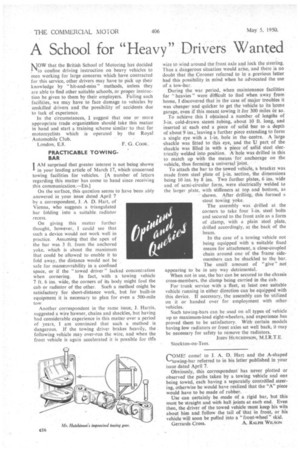A School for "Heavy" Drivers Wanted
Page 52

If you've noticed an error in this article please click here to report it so we can fix it.
NOW that the British School of Motoring has decided to confine driving instruction on heavy vehicles to men working for large concerns which have contracted for this service, other drivers may have to pick up their knowledge by "hit-and-miss" methods, unless they are able to find other suitable schools, or proper instruction be given to them by their employers. Failing such facilities, we may have to face damage to vehicles by unskilled drivers and the possibility of accidents due to lack of experience.
In the circumstances, I suggest that one or more appropriate trade organization should take this matter in hand and start a training scheme similar to that for motorcyclists which is operated by the Royal Automobile Club.
London, E.8. F. G. COOK.
PRACTICABLE TOWINGBAR
' AM surprised that greater interest is not being shownin your leading article of March 17, which'concerned towing facilities for vehicles. [A number of letters regarding this matter has come to hand since receiving this communication.--EDJ
On the surface, this question seems to have been ably answered in your issue dated April 7 by a correspondent, J. A D. Hart, of Vienna, who suggests a triangulated bar folding into a suitable. radiator recess.
On giving this matter further thought, however, I could see that such a device would not work well in practice. Assuming that the apex of the bar was 3 ft. from the anchored yoke, which is about the maximum that could be allowed to enable it to fold away, the distance would not be safe for manceuvrability in a confined space, or if the "towed driver" lacked concentration when cornering. In fact, with a towing vehicle 7 ft. 6 ins, wide, the corners of its body might foul the cab or radiator of the other. Such a method might be satisfactory for short-distance work, but for built-in equipment it is necessary to plan for even a 500-mile tow
tri
Another correspondent in the same issue, J. Harris, suggested a wire hawser, chains and shackles, but having had considerable experience in this matter over a period of years, I am convinced that such a method is dangerous. If the towing driver brakes heavily, the following vehicle may over-run the wire, and when the front vehicle is again accelerated it is possible for this wire to wind around the front axle and lock the steering, Thus a dangerous situation would arise, and there is no doubt that the Coroner referred to in a previous letter had this possibility in mind when he advocated the use of a tow-bar.
During the war period, when maintenance facilities for " heavies " were difficult to find when away from home, I discovered that in the case of major troubles it was cheaper and quicker to get the vehicle to its home garage, even if this meant towing it for 300 miles. or so.
To achieve this I obtained a number of lengths of 3-in, cold-drawn steam tubing, about 10 ft. long, and inserted at each end a piece of solid bar to a depth of about 9 ins., leaving a further piece extending to form a single eye with a 1-in, hole in the centre. A large shackle was fitted to this eye, and the U part of the shackle was filled in with a piece of solid steel electrically welded into position. A hole was drilled in this to match up with the means for anchorage on the vehicle, thus forming a universaijoint.
To attach the bar to the towed vehicle, a bracket was made from steel plate of k-in. section, the dimensions being 10 ins. by 8 ins. Two further plates, 6 ins, wide and of semi-circular form, were electrically welded to the larger plate, with stiffeners at top and bottom, as shown. After drilling, this formed a stout towing yoke.
The assembly was drilled at the corners to take four steel bolts and secured to the front axle as a form of clamp, with a plain steel plate, drilled accordingly, at the back of the beam.
In the case of a towing vehicle not being equipped with a suitable fixed means for attachment, a close-coupled chain around one of the frame sidemembers can be shackled to the bar. The small amount of "give" not appearing to be in any way detrimental.
When not in use, the bar can be secured to the chassis cross-members, the clamp being carried in the cab.
For trunk service with a fleet, at least one suitable vehicle running in either direction can be equipped with this device. If necessary, the assembly can be utilized on it or handed over for employment with other. vehicles.
Such towing-bars can be used on all types of vehicle up to maximum-load eight-wheelers, and experience has proved them to be satisfactory. With certain models having low radiators or front axles set well back, it may be necessary for safety to remove the radiators.
JOHN HtrtainvsoN, M.I.R.T.E. Stockton-on-Tees.
COME! come! to J. A. D. Hart and the A-shaped towing-bar referred to in his letter published in your issue dated April 7.
Obviously, this correspondent has never plotted or observed the paths taken by a towing vehicle and one being towed, each having a separately controlled steering, otherwise he would have realized that the "A" piece would have to be made of rubber.
Use can certainly be made of a rigid bar, but this must be straight and with ball joints at each end. Even then, the driver of the towed vehicle must keep his wits about him and follow the tail of that in front, or his vehicle will soon be pulled into a "front-wheel" skid.
Gerrards Cross. A. RALPH WILSON.
























































































